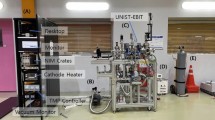Abstract
The precision of atomic mass measurements in a Penning trap is directly proportional to the charge state q of the ion and, hence, can be increased by using highly charged ions (HCI). For this reason, charge breeding with an electron beam ion trap (EBIT) is employed at TRIUMF’s Ion Trap for Atomic and Nuclear science (TITAN) on-line facility in Vancouver, Canada. By bombarding the injected and trapped singly charged ions with an intense beam of electrons, the charge state of the ions is rapidly increased inside the EBIT. To be compatible with the on-line requirements of short-lived isotopes, very high electron beam current densities are needed. The TITAN EBIT includes a 6 Tesla superconducting magnet and is designed to have electron beam currents and energies of up to 5 A and 60 keV, respectively. Once operational at full capacity, most species can be bred into a He-like configuration within tens of ms. Subsequently, the HCI are extracted, pass a Wien filter to reduce isobaric contamination, are cooled, and injected into a precision Penning trap for mass measurement. We will present the first results and current status of the TITAN EBIT, which has recently been moved to TRIUMF after assembly and commissioning at the Max-Planck-Institute (MPI) for Nuclear Physics in Heidelberg, Germany.
Similar content being viewed by others
References
Cabibbo, N.: Phys. Rev. Lett. 10, 531 (1963)
Kobayashi, M., Maskawa, T.: Prog. Theor. Phys. 49, 652 (1973)
Savard, G., et al.: Phys. Rev. Lett. 95, 102,501 (2005)
Dilling, J., Bricault, P., Smith, M., Kluge, H.J., et al.: Nucl. Instrum. Methods Phys. Res. B 204, 492 (2003)
Ball, G., et al.: Phys. Rev. Lett. 86, 1454 (2001)
Levine, M., Marrs, R., Henderson, J., Knapp, D., Schneider, M.: Physica Scripta T22, 157 (1988)
Fuchs, T., Biedermann, C., Radtke, R., Behar, E., Doron, R.: Phys. Rev. A 58, 4518 (1998)
McDonald, J., Bauer, R., Schneider, D.: Rev. Sci. Instrum. 73, 30 (2002)
González-Martínez, A.J.: Ph.D. thesis, University of Heidelberg (2005)
Herrmann, G.: J. Appl. Phys. 29, 127 (1958)
Froese, M.W.: Master’s thesis, University of Manitoba (2006)
Author information
Authors and Affiliations
Corresponding author
Rights and permissions
About this article
Cite this article
Froese, M., Champagne, C., Crespo López-Urrutia, J.R. et al. A high-current electron beam ion trap as an on-line charge breeder for the high precision mass measurement TITAN experiment. Hyperfine Interact 173, 85–92 (2006). https://doi.org/10.1007/s10751-007-9546-z
Published:
Issue Date:
DOI: https://doi.org/10.1007/s10751-007-9546-z




